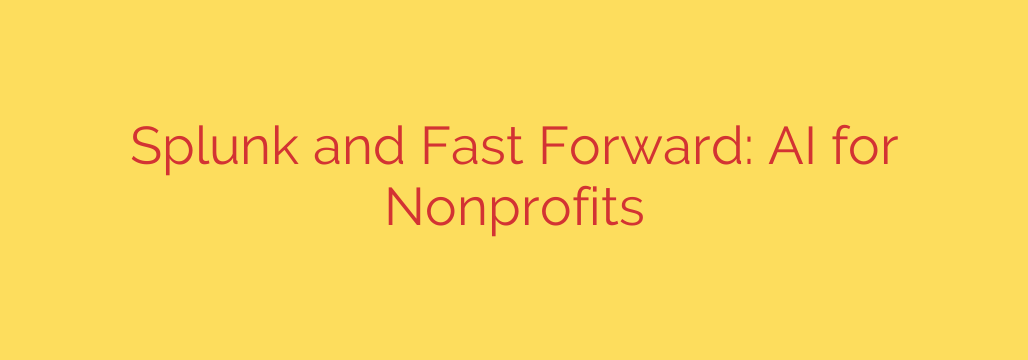
Unlocking Social Impact: The Power of AI and Data for Nonprofits
For decades, nonprofits have been driven by passion, dedication, and a deep commitment to their missions. They work on the front lines, tackling society’s most complex challenges with often limited resources. But a powerful new ally is emerging that promises to multiply their impact: artificial intelligence (AI) and data science.
While once the exclusive domain of tech giants and large corporations, AI is now becoming an accessible and transformative tool for the social sector. By harnessing the power of data, nonprofits can move from intuition-based decisions to evidence-backed strategies, ensuring every dollar, every hour, and every effort is maximized for good.
The Challenge: A Data-Rich, Insight-Poor Sector
Many nonprofit organizations are sitting on a treasure trove of data. From donor information and volunteer hours to program outcomes and community feedback, the information is there. The primary challenge, however, has been the lack of resources—both financial and technical—to analyze it effectively.
The high cost of advanced software, the scarcity of data science talent, and the pressing need to focus on immediate service delivery have historically kept sophisticated data analytics out of reach for many. This creates a critical gap where valuable insights that could drive efficiency and improve outcomes remain undiscovered.
The Solution: How AI Empowers Mission-Driven Work
AI and machine learning provide a powerful solution to this challenge. By automating complex data analysis, these technologies can uncover patterns, predict future trends, and provide clear, actionable insights. This allows nonprofit leaders to make smarter, faster, and more effective decisions.
The core benefits for nonprofits embracing a data-driven culture include:
- Making strategic, data-informed decisions about resource allocation and program development.
- Maximizing impact with limited resources by identifying what’s working and what isn’t.
- Improving operational efficiency by automating repetitive tasks and optimizing workflows.
- Enhancing transparency and accountability with clear metrics to show donors and stakeholders.
Real-World Applications: Data in Action for Social Good
The potential applications of AI in the nonprofit world are vast and inspiring. We are already seeing organizations leverage this technology to achieve incredible results.
Imagine a disaster relief organization using AI to predict where aid will be needed most after a hurricane by analyzing weather patterns, population density, and infrastructure data. Think of a public health nonprofit using machine learning to identify at-risk populations for disease outbreaks, allowing for proactive, targeted interventions.
Other powerful examples include:
- Optimizing Fundraising: AI can analyze donor histories to personalize outreach and predict which campaigns will resonate most strongly with different supporter segments.
- Measuring Program Effectiveness: By analyzing participant data, nonprofits can gain a clear understanding of their long-term impact and refine their programs for better outcomes.
- Scaling Operations: AI can help organizations identify systemic bottlenecks and streamline their processes, enabling them to serve more people without a proportional increase in overhead.
Building an Ecosystem for Tech-for-Good
This transformation isn’t happening in a vacuum. A growing movement of strategic partnerships between tech companies and nonprofit accelerators is making these powerful tools more accessible.
Forward-thinking tech companies are providing their software, funding, and employee expertise to mission-driven organizations. At the same time, nonprofit accelerators are identifying high-potential “tech-for-good” startups and providing them with the support they need to scale their solutions. This collaborative ecosystem creates a powerful flywheel, accelerating the adoption of technology across the entire social sector.
Actionable Tips for Nonprofits to Get Started with Data
Embarking on a data journey can feel daunting, but it doesn’t have to be. Here are a few practical steps your organization can take to begin harnessing the power of its data:
- Start with a Clear Question. Don’t just collect data for the sake of it. Begin by identifying a critical strategic question you need to answer. For example, “Which of our programs has the highest long-term success rate?” or “Where is the greatest unmet need for our services in our community?”
- Take Inventory of Your Current Data. You are likely collecting more data than you realize. Map out all your data sources, from spreadsheets and databases to surveys and website analytics. Understanding what you have is the first step toward using it.
- Seek Out Pro Bono Support and Partnerships. Many tech professionals are passionate about using their skills for good. Reach out to local tech communities or explore corporate volunteer programs to find experts who can help you build your data capabilities.
- Explore Low-Cost and Nonprofit-Specific Tools. Many leading software companies offer significant discounts or even free versions of their products for registered nonprofits. Do your research to find powerful tools that fit your budget.
By embracing a data-driven mindset and leveraging the growing ecosystem of support, nonprofits can unlock new levels of impact. When passion is guided by precision, we can build a more effective, equitable, and data-informed future for everyone.
Source: https://feedpress.me/link/23532/17103161/splunk-and-fast-forward-partner-to-empower-ai-driven-nonprofits








